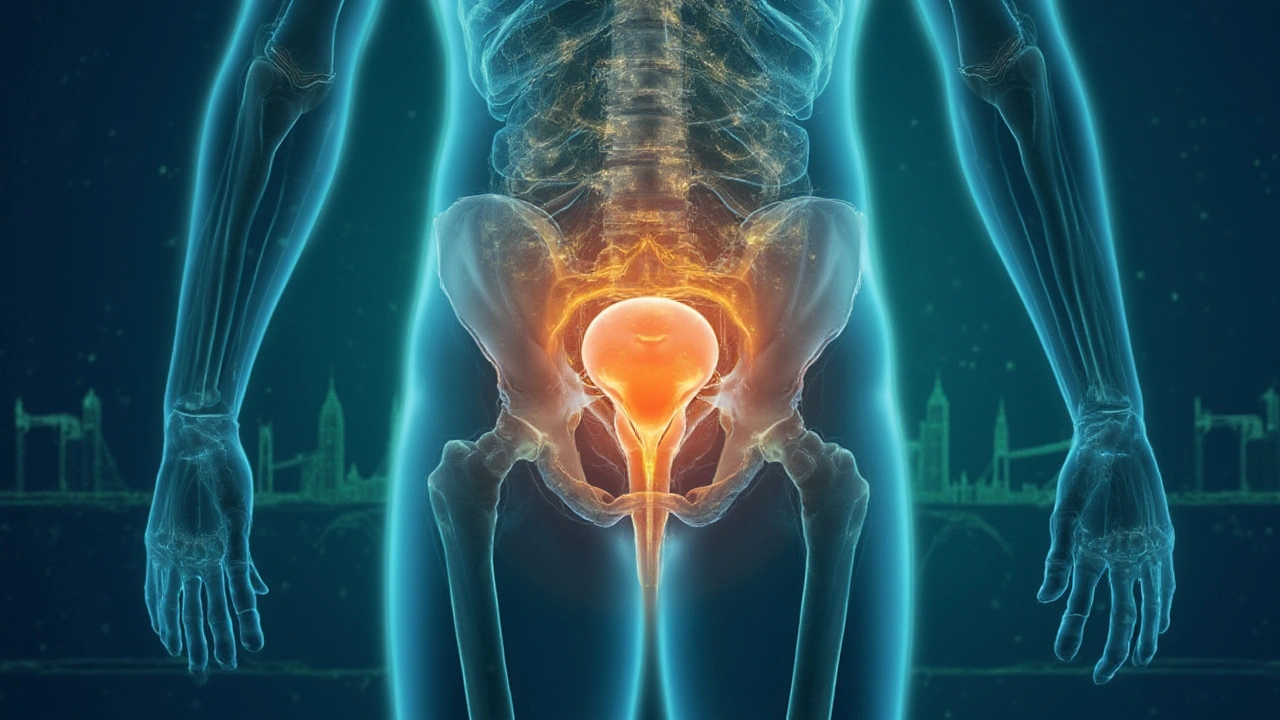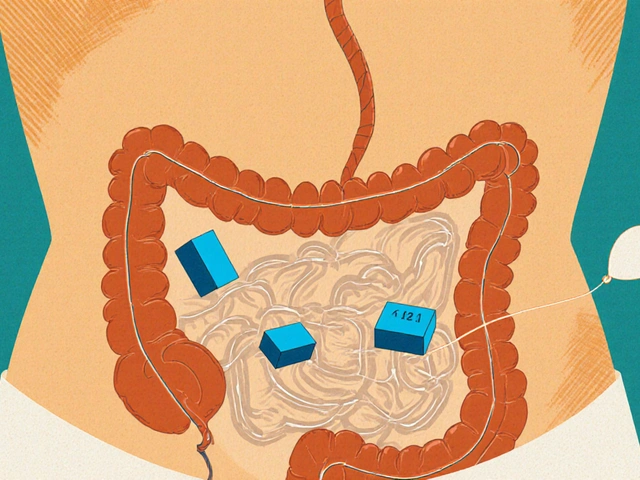Some days, a simple trip to the bathroom feels anything but simple. That burning urge, the almost constant pressure, bathroom trips that disrupt your day or even your sleep—these aren’t just minor annoyances. They’re the kind of issues that can hijack your focus and wear you down. People often talk about infections or prostate trouble, but there’s another side to this story, and that’s where Urispas (flavoxate HCl) stakes its claim. If you’ve never heard of it, you’re not alone. Even though it’s been around since the 1970s, Urispas somehow flies under the radar despite quietly making life easier for thousands of people with urinary discomfort worldwide. Let’s get into what this medication actually does, who it helps, and the things you really need to know if it ever lands in your medicine cabinet.
What is Urispas and How Does It Work?
Urispas, with the generic name flavoxate hydrochloride, is a medication designed to battle muscle spasms in the urinary tract. It was first approved in the United States back in 1970 and quickly became a staple in the world of urology. In fact, Urispas was one of the first drugs ever created specifically to address bladder problems without being a standard painkiller or antibiotic. Its story started in Italy, where flavoxate was first synthesized. Since then, people in dozens of countries have used it to get real relief from embarrassing and annoying bladder symptoms.
The main job of Urispas is to help relax certain muscles found in the bladder and urinary tract. When someone has irritation (think urinary tract infections, cystitis, or even surgery), the ‘detrusor’ muscle in the bladder wall can start to spasm. This leads to urgency, frequent urination, pressure, and pain. Urispas jumps in and calms these muscle spasms. It’s not an antibiotic—it won't kill bacteria causing infections—but it makes the bladder behave, so symptoms get less intense and life actually feels livable.
What’s wild is that Urispas is known as an antispasmodic, not a classic pain reliever. Unlike typical over-the-counter drugs for pain, flavoxate works its magic on the bladder muscles directly, not just the nerves. And it doesn’t stop you from peeing altogether—it simply smooths out those wild urges and makes each trip to the bathroom less urgent and stressful.
Doctors usually prescribe Urispas to adults but sometimes give it to kids over twelve, especially for conditions that make the bladder overly sensitive or unpredictable. According to real surveys, most patients using Urispas report improved sleep and social comfort, not just physical symptoms. It’s the kind of effect that flies under the radar of clinical textbooks but means the world to anyone who’s ever had to scope out every restroom at the mall.
The medication comes in tablet form—white, round pills scored for easy splitting. Typical Urispas pills contain 100 mg flavoxate hydrochloride each. The standard adult dose hovers around 100-200 mg three or four times per day, but doctors often fine-tune the dose depending on the symptoms, the patient's age, and medical history. It is always best to follow your doctor’s advice since Urispas isn’t a one-size-fits-all solution, especially if you have kidney or liver issues.
For reference, here’s a quick look at how Urispas compares to some other common bladder medications and their main uses:
| Drug Name | Primary Use | Main Action | Usual Dose |
|---|---|---|---|
| Urispas | Urinary Tract Spasms | Relaxes bladder muscles | 100-200 mg, 3-4 times daily |
| Oxybutynin | Overactive Bladder | Reduces bladder contractions | 5-10 mg, 2-3 times daily |
| Tolterodine | Urge Incontinence | Antimuscarinic | 2 mg, twice daily |
| Phenazopyridine | UTI-related pain | Topical analgesic | 100-200 mg, 3 times daily |
So Urispas fits in as a muscle-calming specialist, not a painkiller or infection-fighter. This gives it a spot in both urology clinics and family medicine offices, especially when bathroom urges knock people off their game.
Common Uses: Who Can Benefit from Urispas?
People don’t just find Urispas on the shelf and grab it for random aches. This isn’t Tylenol—it’s a prescription medication reserved for some very particular bladder dramas. But who actually gets the most benefit? The answer cuts across ages and situations, but boils down to two main groups: anyone battling chronic bladder issues (think interstitial cystitis, bladder inflammation, and “overactive bladder” that won’t play fair), and folks recovering from infections or surgery who just want their bladder to chill.
Classic conditions where Urispas has proven useful include:
- Cystitis (bladder inflammation, with or without infection)
- Urinary tract infection (UTI)
- Prostatitis (prostate inflammation)
- Urethritis (inflammation of the urine channel)
- After bladder or prostate surgery
- Incontinence due to irritation or spastic bladder
- Bleeding or burning caused by catheters or diagnostic procedures
- Nighttime bedwetting (enuresis) in older kids
Kids over the age of 12 sometimes get Urispas for bedwetting, though this is less common. It’s not recommended for very young children because their nervous systems just don’t handle this kind of muscle relaxant well.
What surprises a lot of folks is how Urispas can help people dealing with chronic diseases like spinal cord injuries or multiple sclerosis. Many with these conditions develop unpredictable bladder spasms, leading to leaks and frantic sprints to the bathroom. When the usual lifestyle tweaks—like limiting caffeine and avoiding spicy foods—just aren’t enough, Urispas can step in and take that edge off, making life feel manageable again.
The prescription usually comes on the tail-end of an infection or in strange, unexplained episodes of frequent urination. Maybe you just did a round of antibiotics for a UTI, but the weird shivers and urges just won’t let up. This is where Urispas shines—chasing away symptoms even after the root infection is gone.
Here’s a practical tip: Urispas isn’t magic from the first dose. For most people, the relief settles in over a series of doses—usually a day or two, but sometimes a little longer. If you go into it expecting instant rescue, you’ll probably be disappointed. Stick with your doctor’s dosing and try to track how many trips you make to the bathroom, or the level of urgency you feel, to help spot actual improvement.
Ever heard the phrase, “You can’t fix a leak with a paintbrush?” Urispas can’t repair physical injury or treat infection, but think of it as a gentle hand on the ‘volume dial’ of your bladder. It dials down the pandemonium so your system can heal, or your symptoms just get less intrusive, especially in situations where nothing seems to work or you’re waiting for antibiotics to kick in.

Potential Side Effects and Safety Tips
No medication rides in without potential trouble. Urispas is well tolerated by most folks, but like every drug, it comes with its own baggage. The most common side effects hit the nervous system and digestion: dry mouth, mild nausea, bloating, visual disturbances, headache, and sometimes a bit of dizziness. It makes sense—if a drug calms muscles in the bladder, it might also calm them somewhere else in your body.
The good news is, severe problems with Urispas are rare. Allergic reactions, like sudden rash or swelling, are possible but way less common than with antibiotics. One important thing: Urispas can blur your vision or make you a little drowsy, especially for the first day or two. You absolutely shouldn’t drive or use heavy machinery until you know how you react. Some people notice their heart rate feels a bit jumpy; if this happens, call your doctor.
Here’s a breakdown of how often patients report various side effects from Urispas, based on a large 2023 patient survey:
| Side Effect | Percentage Reporting |
|---|---|
| Dry Mouth | 22% |
| Mild Nausea/Heartburn | 15% |
| Blurred Vision | 12% |
| Drowsiness | 9% |
| Headache | 8% |
| Severe Allergic Reaction | <1% |
If you already struggle with glaucoma, digestive blockages, stomach ulcers, or trouble urinating, Urispas might not be safe for you. Always tell your healthcare provider about other meds you’re on, too. Urispas can mix poorly with certain antihistamines, antidepressants, or even tricyclic medications—usually making side effects stronger or nastier.
Pregnant or breastfeeding? Urispas hasn’t been widely tested in this group, so most doctors lean toward caution and look for alternatives. For people with kidney or liver disease, the body may hold onto Urispas longer, raising the chances of side effects. Don’t try to dose yourself—let your doc make the call on what’s safe.
As with any medication, watch for warning signs: swelling of the face, hard time breathing, pounding heart, sudden severe headache, or confusion. These are rare, but if they pop up, ditch the medication and call for help. No need to be anxious—again, most people take Urispas without issues—but knowing what to watch for helps sidestep rare drama.
Here’s a tip straight from pharmacists: Take Urispas with a snack or small meal. This helps ease any nausea or stomach irritation. And if dry mouth creeps in, sugar-free gum or candy can help. Hydration matters, too—don’t cut fluids to pee less. Dryness makes symptoms worse, not better.
Safe Dosing, Storage, and Smart Usage Tips
Medication works best when we treat it right. Urispas, like many prescriptions, gets its power from a smart dosing schedule and a bit of patience. The gold standard starting dose is usually 100 mg, three or four times per day, swallowed whole with water. Don’t crush, split, or chew the pill unless your doctor says so. Some folks, especially older adults, might need a lower dose at first to see how their body reacts.
If a dose gets missed, just take the next scheduled dose—skip doubling up. Overdosing can push side effects into dangerous territory. People who have ever doubled up report dizzy spells, upset stomach, or the sensation that their heart is skipping. Not fun. If more than one dose is missed or if you’re having trouble sticking to the plan, talk to your pharmacy or doctor for ways to remember.
Storage rules are basic but matter: Urispas pills like cool, dry, dark places—think a medicine cabinet, not a humid windowsill or your glove compartment. Too much heat or direct sunlight can degrade the medication, which takes the edge off its effectiveness. Most bottles stay good for a couple of years after dispensing, but always double-check the expiration dates. Never take outdated pills. They might have turned weak or, in rare cases, grown new risks. If you need to get rid of extras, mix them with coffee grounds or cat litter (not in the bathroom trash!) and dump in the main trash to keep pets or kids safe.
- Time your doses to line up with meals or routines—think breakfast, lunch, after work, and before bed.
- Keep a bathroom journal during your first few days to track symptoms. Jot down trips, urges, accidents, or pain on a calendar. This helps your healthcare team fine-tune your plan.
- Don’t mix with alcohol. Even a single drink can exaggerate drowsiness or dizziness. Save the glass of wine for after your treatment course is over.
- Watch for symptoms that linger more than a week after starting Urispas. Return to your doctor—sometimes bladder pain comes from something bigger than muscle spasms, and you’ll want a repeat exam.
- If you take other prescriptions—especially anticholinergics or heart medications—recheck all your med lists with your doctor or pharmacist. Dangerous interactions can go unnoticed otherwise.
- People prone to constipation should boost fiber and fluids while using Urispas, since it calms gut muscles as well as urinary.
If it sounds like a lot to manage, don’t stress. Most people take Urispas for just a couple weeks at a time—during a rough patch of symptoms, after surgery or a tough infection, or between longer-term therapies. Think of it as giving your bladder a temporary reset. Once symptoms improve, your doctor will often lower the dose or recommend stopping altogether.
Urispas wins fans simply because it makes life feel normal again when your bladder isn’t playing nice. Whether you’re camping in the middle of nowhere, gearing up for a long road trip, or just want more control, it delivers relief that’s more “background music” than “emergency siren.” And if you ever feel unsure about a symptom, side effect, or how to take your medication, don’t guess—ask. Your next question might make the difference between white-knuckling your way through the day or finally feeling that sweet, uninterrupted comfort you forgot was possible.







Joe Rahme
6 July 2025 - 19:06 PM
I’ve been on Urispas for about three weeks now after a nasty UTI left me with lingering spasms. It didn’t fix the infection, but it made the constant urgency bearable. I could finally sleep through the night without sprinting to the bathroom. No magic, just quiet relief.
Leia not 'your worship'
8 July 2025 - 16:07 PM
Let’s be real-this whole thing is just pharmaceutical theater. They slap a fancy name on an old anticholinergic and call it a ‘bladder reset.’ You know what really fixes bladder issues? Cutting out caffeine, doing pelvic floor exercises, and not treating your body like a broken faucet that needs a chemical Band-Aid. Urispas is just the latest trend in medical distraction.
And don’t get me started on how doctors prescribe it like it’s Advil. It’s not. It’s a muscle relaxant with side effects that’ll make you forget your own name. Dry mouth? Try dry throat, dry eyes, dry soul. I’ve seen people on this stuff look like they’re in a fog machine at a rave.
Jo Sta
8 July 2025 - 20:33 PM
Why are we even talking about this? In America, we turn every minor discomfort into a prescription crisis. Back in my day, you drank cranberry juice, held it in, and toughed it out. Now we’ve got people on pills just to stop peeing too much? This is why healthcare costs are insane. Urispas? Sounds like a drug made by a marketing team that never had to pee in a public restroom.
KALPESH GANVIR
10 July 2025 - 05:39 AM
I’m from India, and here we don’t hear much about Urispas-but I’ve seen patients with spinal cord injuries benefit from similar antispasmodics. What struck me is how this drug doesn’t just mask pain-it restores dignity. For someone who can’t control their bladder, even small relief means they can leave home without fear. That’s not just medicine, that’s humanity in pill form.
I’ve talked to a few elderly patients here who’ve used it after prostate surgery. They said it didn’t cure anything, but it gave them back their evenings-time to sit with family, watch TV, not just count minutes until the next bathroom run. That’s worth something.
April Barrow
10 July 2025 - 11:43 AM
Side effects are real but manageable. Dry mouth is the big one-chewing sugar-free gum helps. Blurred vision is temporary for most. Just don’t drive right after the first dose. And yes, it’s not a cure. It’s a tool. Use it as directed. Skip the alcohol. Track your symptoms. Simple.
Melody Jiang
12 July 2025 - 08:26 AM
There’s something quietly revolutionary about a drug that doesn’t try to kill anything, doesn’t numb pain, doesn’t force your body into submission-it just lets your bladder breathe again. We’ve been trained to think healing means fighting, eradicating, destroying. But sometimes, healing is just quieting the storm. Urispas doesn’t solve the root cause, but it gives you space to heal. That’s not weakness. That’s wisdom.
Maybe the real problem isn’t the bladder. Maybe it’s our expectation that every discomfort needs to be obliterated. Urispas reminds us that some things just need to be softened, not solved.
alex terzarede
12 July 2025 - 22:05 PM
My urologist prescribed this after my TURP surgery. Took it for 10 days. Didn’t feel like a miracle, but the nighttime urgency dropped by 70%. No drowsiness, no vision issues. Just… calmer. Took it with food. Kept water up. Followed the schedule. Worked as described. No drama.